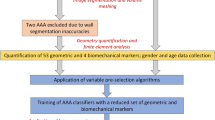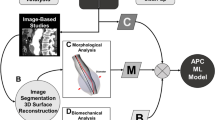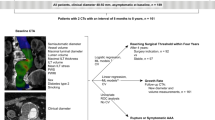Abstract
Abdominal aortic aneurysm (AAA) is an asymptomatic aortic disease with a survival rate of 20% after rupture. It is a vascular degenerative condition different from occlusive arterial diseases. The size of the aneurysm is the most important determining factor in its clinical management. However, other measures of the AAA geometry that are currently not used clinically may also influence its rupture risk. With this in mind, the objectives of this work are to develop an algorithm to calculate the AAA wall thickness and abdominal aortic diameter at planes orthogonal to the vessel centerline, and to quantify the effect of geometric indices derived from this algorithm on the overall classification accuracy of AAA based on whether they were electively or emergently repaired. Such quantification was performed based on a retrospective review of existing medical records of 150 AAA patients (75 electively repaired and 75 emergently repaired). Using an algorithm implemented within the MATLAB computing environment, 10 diameter- and wall thickness-related indices had a significant difference in their means when calculated relative to the AAA centerline compared to calculating them relative to the medial axis. Of these 10 indices, nine were wall thickness-related while the remaining one was the maximum diameter (Dmax). Dmax calculated with respect to the medial axis is over-estimated for both electively and emergently repaired AAA compared to its counterpart with respect to the centerline. C5.0 decision trees, a machine learning classification algorithm implemented in the R environment, were used to construct a statistical classifier. The decision trees were built by splitting the data into 70% for training and 30% for testing, and the properties of the classifier were estimated based on 1000 random combinations of the 70/30 data split. The ensuing model had average and maximum classification accuracies of 81.0 and 95.6%, respectively, and revealed that the three most significant indices in classifying AAA are, in order of importance: AAA centerline length, L2-norm of the Gaussian curvature, and AAA wall surface area. Therefore, we infer that the aforementioned three geometric indices could be used in a clinical setting to assess the risk of AAA rupture by means of a decision tree classifier. This work provides support for calculating cross-sectional diameters and wall thicknesses relative to the AAA centerline and using size and surface curvature based indices in classification studies of AAA.




Similar content being viewed by others
Change history
18 September 2018
This erratum is to correct the variable name on the left hand side of Eq. (2). The correct variable name is “Diameter” rather than the stated “Area.”
References
Conlisk, N., A. J. Geers, O. M. McBride, D. E. Newby, and P. R. Hoskins. Patient-specific modelling of abdominal aortic aneurysms: the influence of wall thickness on predicted clinical outcomes. Med. Eng. Phys. 38:526–537, 2016.
Darling, R. C., C. R. Messina, D. C. Brewster, and L. W. Ottinger. Autopsy study of unoperated abdominal aortic aneurysms. The case for early resection. Circulation 56:II161–II164, 1977.
Di Martino, E. S., A. Bohra, J. P. V. Geest, N. Gupta, M. S. Makaroun, and D. A. Vorp. Biomechanical properties of ruptured versus electively repaired abdominal aortic aneurysm wall tissue. J. Vasc. Surg. 43:570–576, 2006.
Doyle, B. J., A. Callanan, P. E. Burke, P. A. Grace, M. T. Walsh, D. A. Vorp, and T. M. McGloughlin. Vessel asymmetry as an additional diagnostic tool in the assessment of abdominal aortic aneurysms. J. Vasc. Surg. 49:443–454, 2009.
Gasser, T. C., M. Auer, F. Labruto, J. Swedenborg, and J. Roy. Biomechanical rupture risk assessment of abdominal aortic aneurysms: model complexity versus predictability of finite element simulations. Eur. J. Vasc. Endovasc. Surg. 40:176–185, 2010.
Gharahi, H., B. Zambrano, C. Lim, J. Choi, W. Lee, and S. Baek. On growth measurements of abdominal aortic aneurysms using maximally inscribed spheres. Med. Eng. Phys. 37:683–691, 2015.
Golledge, J., P. E. Norman, M. P. Murphy, and R. L. Dalman. Challenges and opportunities in limiting abdominal aortic aneurysm growth. J. Vasc. Surg. 65:225–233, 2017.
Healey, C. T., M. Neilson, D. Clark, A. Schanzer, and W. Robinson. Predicting mortality of ruptured abdominal aortic aneurysms in the era of endovascular repair. Ann. Vasc. Surg. 38:59–63, 2017.
Kontopodis, N., E. Metaxa, M. Gionis, Y. Papaharilaou, and C. V. Ioannou. Discrepancies in determination of abdominal aortic aneurysms maximum diameter and growth rate, using axial and orthogonal computed tomography measurements. Eur. J. Radiol. 82:1398–1403, 2013.
Kontopodis, N., D. Pantidis, A. Dedes, N. Daskalakis, and C. V. Ioannou. The –not so– solid 5.5 cm threshold for abdominal aortic aneurysm repair: facts, misinterpretations, and future directions. Front. Surg. 3:1, 2016.
Kuhn, M., S. Weston, N. Coulter, and R. Quinlan. C50: C5.0 decision trees and rule-based models. R package version 0.1. 0-21. https://cran.r-project.org/web/packages/C50/C50.pdf.
Lederle, F. A., S. E. Wilson, G. R. Johnson, D. B. Reinke, F. N. Littooy, C. W. Acher, D. J. Ballard, L. M. Messina, I. L. Gordon, and E. P. Chute. Immediate repair compared with surveillance of small abdominal aortic aneurysms. N. Engl. J. Med. 346:1437–1444, 2002.
Lee, K., J. Zhu, J. Shum, Y. Zhang, S. C. Muluk, A. Chandra, M. K. Eskandari, and E. A. Finol. Surface curvature as a classifier of abdominal aortic aneurysms: a comparative analysis. Ann. Biomed. Eng. 41:562–576, 2013.
Manning, B. J., T. Kristmundsson, B. Sonesson, and T. Resch. Abdominal aortic aneurysm diameter: a comparison of ultrasound measurements with those from standard and three-dimensional computed tomography reconstruction. J. Vasc. Surg. 50:263–268, 2009.
Martufi, G., E. S. Di Martino, C. H. Amon, S. C. Muluk, and E. A. Finol. Three-dimensional geometrical characterization of abdominal aortic aneurysms: image-based wall thickness distribution. J. Biomech. Eng. 131:061015, 2009.
Mower, W. R., L. J. Baraff, and J. Sneyd. Stress distributions in vascular aneurysms: factors affecting risk of aneurysm rupture. J. Surg. Res. 55:155–161, 1993.
Novak, K., S. Polzer, T. Krivka, R. Vlachovsky, R. Staffa, L. Kubicek, L. Lambert, and J. Bursa. Correlation between transversal and orthogonal maximal diameters of abdominal aortic aneurysms and alternative rupture risk predictors. Comput. Biol. Med. 83:151–156, 2017.
Pappu, S., A. Dardik, H. Tagare, and R. J. Gusberg. Beyond fusiform and saccular: a novel quantitative tortuosity index may help classify aneurysm shape and predict aneurysm rupture potential. Ann. Vasc. Surg. 22:88–97, 2008.
Raghavan, M. L., J. Kratzberg, E. M. C. de Tolosa, M. M. Hanaoka, P. Walker, and E. S. da Silva. Regional distribution of wall thickness and failure properties of human abdominal aortic aneurysm. J. Biomech. 39:3010–3016, 2006.
Raut, S. S., P. Liu, and E. A. Finol. An approach for patient-specific multi-domain vascular mesh generation featuring spatially varying wall thickness modeling. J. Biomech. 48:1972–1981, 2015.
Shang, E. K., D. P. Nathan, E. Y. Woo, R. M. Fairman, G. J. Wang, R. C. Gorman, J. H. Gorman, and B. M. Jackson. Local wall thickness in finite element models improves prediction of abdominal aortic aneurysm growth. J. Vasc. Surg. 61:217–223, 2015.
Shelmerdine, S., J. Barber, and C. George. Applications of Laplace’s law in clinical medicine: a radiological pictorial review. Br. J. Hosp. Med. 74:451–456, 2013.
Shum, J., E. S. DiMartino, A. Goldhammer, D. H. Goldman, L. C. Acker, G. Patel, J. H. Ng, G. Martufi, and E. A. Finol. Semiautomatic vessel wall detection and quantification of wall thickness in computed tomography images of human abdominal aortic aneurysms. Med. Phys. 37:638–648, 2010.
Shum, J., G. Martufi, E. Di Martino, C. B. Washington, J. Grisafi, S. C. Muluk, and E. A. Finol. Quantitative assessment of abdominal aortic aneurysm geometry. Ann. Biomed. Eng. 39:277–286, 2011.
Shum, J., A. Xu, I. Chatnuntawech, and E. A. Finol. A framework for the automatic generation of surface topologies for abdominal aortic aneurysm models. Ann. Biomed. Eng. 39:249–259, 2011.
Szilagyi, D. E., R. F. Smith, F. J. DeRusso, J. H. P. Elliott, and F. W. Sherrin. Contribution of abdominal aortic aneurysmectomy to prolongation of life. Ann. Surg. 164:678, 1966.
Tang, A., C. Kauffmann, S. Tremblay-Paquet, S. Elkouri, O. Steinmetz, F. Morin-Roy, L. Cloutier-Gill, and G. Soulez. Morphologic evaluation of ruptured and symptomatic abdominal aortic aneurysm by three-dimensional modeling. J. Vasc. Surg. 59:894.e3–902.e3, 2014.
Vorp, D. A. Biomechanics of abdominal aortic aneurysm. J. Biomech. 40:1887–1902, 2007.
Acknowledgments
The authors have no conflicts of interest to disclose and would like to acknowledge research funding from National Institutes of Health award R01HL121293, American Heart Association award 15PRE25700288, and an American Heart Association student scholarship in cardiovascular disease. The content is solely the responsibility of the authors and does not necessarily represent the official views of the National Institutes of Health or the American Heart Association.
Author information
Authors and Affiliations
Corresponding author
Additional information
Associate Editor Estefanía Peña oversaw the review of this article.
Electronic supplementary material
Below is the link to the electronic supplementary material.
Rights and permissions
About this article
Cite this article
Parikh, S.A., Gomez, R., Thirugnanasambandam, M. et al. Decision Tree Based Classification of Abdominal Aortic Aneurysms Using Geometry Quantification Measures. Ann Biomed Eng 46, 2135–2147 (2018). https://doi.org/10.1007/s10439-018-02116-w
Received:
Accepted:
Published:
Issue Date:
DOI: https://doi.org/10.1007/s10439-018-02116-w




